What is the significance of Potter Greens?
Larch and Black spruce
Trees that tolerate wet peaty soils
Natural asset mapping has helped Edmonton’s urban planners to know that larch (Tamarack) and black spruce are the least common forest types in Edmonton. These rare stands make up only 0.001% of the City’s land. Potter Greens is such land and in addition it is composed of rare wetlands.
Dec 2023 ERVCC members visited the peaty land that is up for sale at Potter Greens. The city sent notification to its large list of developers listing a sale price of 1.8 million. The city has said that if the land does not sell, two options will be pursued, buy the land for green space or develop the land themselves. Given the rarity of the land type and the importance of wetlands, ERVCC wonders if this land is best saved as green space.
To read and hear the discussion at city hall visit here. Basically 17 HA of natural area was purchased in 2005 for green space and some development. It is unclear when the smaller 2HA property (hatched above) was zoned RF5. At this point the land is for sale.
Here are the current scenarios the city is considering:
The hydrology of the area is now pretty messed up but isn’t it still worth preserving to connect people to a rare area?
The Lewis Farms community league notes that The Muskakosi Natural Area was once known as the McDonagh Peatland. Prior to the residential and recreational development of the area, it was approximately 35 hectares in size. It’s characterised by its black spruce (Picea mariana) and tamarack (Larix laricina) tree community, and marl pools. An assessment in 1993 identified that the ecosystem is highly sensitive to any disturbance that would alter the hydrological conditions of the site. Recently the city has built another road and cut trees to allow developers to view the property that is left. There has been much disruption of its natural drainage systems. As a result of these and other factors, the vegetation community is shifting to resemble that of a treed swamp rather than that of a peatland. Sometimes vegetation community transitions can be predicted based on the current tree canopy and understory plant communities. In the case of the Muskakosi Natural Area, it is predicted that the decline of the black spruce tamarack dominated tree community will be replaced by a mixed tree community of balsam poplar (Populus balsamifera), white spruce (Picea glauca), and black spruce.
If this land is not sold over the winter ERVCC would like to ask decision makers to consider retention as a natural area.



